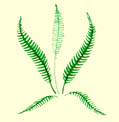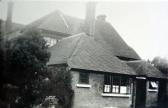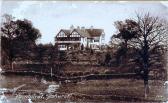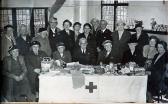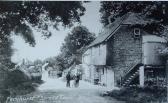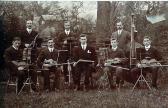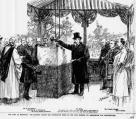The Fernhurst Society
A Glimpse of Edwardian Fernhurst: social life
by Christine Maynard, 2004.
Click on any image to see a larger version (note: the larger images may take a minute to download over slow internet connections).
To end our look at life in Fernhurst a hundred years ago I’d like to talk about the social side. It was a small rural community with most people employed as agricultural labourers on low wages, but that didn’t stop people enjoying themselves, or indeed, educating themselves. There was a wide range of evening classes, a library in the Working Men’s Institute (though not as well used as the vicar would like), clubs, dances, whist drives and lantern lectures.
Rather than just list all the events and organisations that made social life in Fernhurst so pleasant, I thought it would give a better picture if we just looked at a few of them – the Ancient Order of Foresters, the Village Hall, the Garden Fete and finally, the big event of the decade, King Edward VII’s royal progress through Fernhurst in 1903.
Let’s start with the Village Hall. In December 1907, it was proposed that a parish room should be built – social events and meetings up to this time had taken place in the church schoolroom or vicarage barn. Critics argued that until Fernhurst doubled its population (then about 900) current facilities should continue to suffice, but others saw the Parish Room becoming the social centre of village life, as the church was the religious centre. It was suggested that a temporary building should be erected to assess the need. It should be a project for the whole village, irrespective of class, denomination and politics.
It was soon realised that a small temporary parish room would be inadequate for future requirements and that a permanent building capable of seating 250 would be a better option. A. H. Brownrigg was appointed architect with the brief that the cost not to exceed £700, plus £100 for furnishing, lighting, etc and his fees.
Work would not begin though until £500 had been raised. A site
on the Midhurst Road was offered by Owen Scripps Tudor as well as a donation
of £50, plus an anonymous donation of £250, that got the fund
off to a good start.
This is Fred Gale, a local builder (pictured in the 1950s), who, along with John Slade, was awarded the contract. The workforce was almost entirely Fernhurst men, partly in order that village labour might have employment during the winter. By the way, the oak used had been felled from the Fernhurst side of Blackdown in 1905.
Fund raising events continued during the summer and autumn of 1908 and the foundation stone was laid by Mrs Barton, the vicar’s wife, in November. By April 1909 the village had raised £586 and the building was nearing completion.
In keeping with the self-help ideals, it was felt that although contributions from friends outside the parish are very much appreciated, no-one unconnected with Fernhurst should be asked until local resources are exhausted.
Although this photo is dated 1929, the Village Hall is pretty much as it was when it was opened on 22 Apr 1909 by Mrs Barton, who had also laid the foundation stone just five months before.
There was a grand opening ceremony and by 4pm the hall was full. Tea was served to 200. A brief entertainment comprising songs by Miss Salvin and Miss Lucy and poems recited by Miss King followed. In the evening a fairy play called ‘Briar Rose’ performed by the Girls Club, who made all their own costumes and scenery, followed by a dance.
A Village Hall Recreation Committee was soon set up to organise winter
amusements and Fernhurst enjoyed a packed season of amateur dramatics,
whist drives, lantern lectures and other entertainments during the cold
winter months. Within two years, the Village Hall was being considered
as a village necessity rather than a luxury and the Recreation Committee
a village institution providing wholesome recreation. For many years the
Recreation Committee only organised social events in and for the Village
Hall. Now of course we associate it purely with sports.
This is Ashurst in 1908,
the home of Mr and Mrs Daniel King, who were very much involved with the
village both on the sporting and social fronts. Mrs King organised concerts
for the Village Hall and other worthy causes, often taking part herself.
It is therefore not surprising that the couple presented the Hall with
a new piano, which was much appreciated.
Although this photo was taken in the 1950s it gives you an idea of how the stage room would have looked when it was first built. One of the users was the Club for Girls and Young Women. They did needlework, dressmaking, embroidery etc, while a suitable book was read aloud. There was also music and fireside chats as well as Swedish Drill and dancing after. It was remarked that there was too much giggling going on during the drill for it to be of much benefit, but hoped that the girls would soon get over it and do it properly.
The Garden Fete
In 1912 the Recreation Committee organised a Village Fete and Flower Show on August Bank Holiday Monday in the Vicarage Gardens. In true village tradition, a large committee was formed. The day included a flower show, sports events, a pierrot troupe gave a concert among the trees and about 60 schoolchildren sang and gave an excellent display of drill. As dusk fell fairy lamps marked out the lawn for dancing, a promenade concert and a play was also performed.
That was such a success that the following year a second one was held and raised nearly £50 towards Village Hall costs. No fewer than 80 people assisted to make the day an even bigger success than the previous year. The sale of work was particularly successful, with the tent bright and beautiful with Japanese decorations and the Handicrafts Exhibition was an interesting and decidedly successful experiment with exhibits of real artistic value and cunning workmanship including a model of the Village Hall.
Not everything went to plan and some of the hoped-for entertainers were
not available, but the evening show more than made up for it. An exhibition
of hoop-making was quite a feature and must have been an unfamiliar sight
to many who came from outside, and the shooting gallery was highly popular
with the sporting section of the community.
I know this is a very familiar picture to many of you, but I would like to you particularly look at the side entrance, which led up to the meeting room where many village activities were held, such as meetings of the Ancient Order of Foresters. They were the largest organisation in the village and the vicar considered then a splendid example of what can be done by self-help.
Until the 1914-18 War, the local branch of the Ancient Order of Foresters used to hold a Club Day. Usually the Club Day started on the Sunday evening with a church parade of members wearing their AOF scarves with the juveniles carrying the banner and led by the Midhurst and Haslemere Bands with collecting boxes for Haslemere Hospital.
Then on the Monday a holiday was enjoyed and at about 1.30 they would all sit down to a Dinner, usually at the Spread Eagle. Afterwards there was a fair, which was held on the field in Glebe Road, now part of the cemetery. There were roundabouts pulled by horses, swings, coconut shies and stalls of every description, which kept going until well into the night, the whole lit by gas flares and oil and candle lamps.
But the Ancient Order of Foresters wasn’t just about social events. It was a Benevolent Society to which the majority of villagers belonged and was a national organisation. A subscription to the Society was considered a very necessary investment, particularly in the early 1900s when it was first formed. This was before any National Health Act. Members – male and female – could join at the age of 16, and for an average amount of 26/- (£1.30) per annum could obtain help with dental and optical charges, free medical treatment and medicine. Weekly sick pay was about 12/- or 60p. When medical treatment became free under the National Health, financial help continued to be given for any sort of hardship as well as sick pay.
Each local branch was known by its own court name and number. Fernhurst’s court name was ‘Pride of the Border’, no. 4354. Funerals were attended by Court members wearing their scarves in reverse, where many had a black rosette. Three members walked on each side of the coffin and a prayer specially composed for the Ancient Order of Foresters was read over the grave by either the Chief Ranger or Court Secretary.
Sadly, with membership having fallen below 50, the Fernhurst Court had to be amalgamated with the Haslemere Court in 1968, as the National Health Service and Social Services had taken the place of the Foresters’ benefits.
No social event during the early years of the 20th century was complete without the Fernhurst String Band.
Although this photo would appear to be from the 1920s, this could well have been the line-up for at least the previous ten years. Certainly Mr Andrews, the schoolmaster, seen second from the left in the back row, had formed the group by 1902. Other members shown here are Jim Puttick, the painter and decorator, Mr Brooks, head gardener at Blackdown House, Mr Whiting, who lived in Glebe Road, Mr Russell, a printer, brothers E. and G. Parminter, who were both tailors and Walter Payne, the garage owner.
Here are just a few of their engagements. In Mar 1904 there was an excellent entertainment, long and varied, given by the Band and the newly formed Choral Class, later known as the Choral Society. The number of encores testified to the pleasure the performers gave. Two guineas was raised for the Coal and Clothing Bonus Fund.
At another concert in May of the following year, they gave a spirited rendering of American cakewalk music, again in aid of the Coal and Clothing Club. They also gave a series of promenade concerts throughout the summer in the Vicarage Grounds, which were attended by several hundreds.
During their 1906 season, the band particularly enjoyed the evening when they were augmented by musicians from other local bands and comprised about twenty performers. There were songs, solos and encores galore, but one of the audience remarked that as a whole the concert was thoroughly enjoyed, though perhaps a little too long!
At an open air dance they organised in August 07 it was noted that ‘best
thanks are due to the moon whose efforts at illumination were highly successful’.
Just picture the scene!
As a last look at Fernhurst in the early years of the 20th century, we turn to the day the king came to Fernhurst in November 1903.
A general holiday was declared when Edward VII passed through the village on his way to lay the foundation stone of the new Sanatorium. In order to honour the event, three triumphal arches were erected, at a cost of £5.9s 3d, one at the north end of the parish by the Sussex Bell public house, another at the Cross and the third on Henley Common to the south, the idea being to greet the king at the extremities as well as the centre of the parish.
The king arrived at Haslemere station and travelled in an open carriage along Foundry Lane, renamed King’s Road in his honour. The route all along between Haslemere and the top of Henley Hill was charmingly decorated and at intervals there were stands and groups of enthusiastic sightseers. Camelsdale children had an excellent view from the garden of the Sussex Bell public house as he passed through. On reaching the top of Friday’s Hill, the king was apparently very worried as he thought that the horses were going too quickly down the steep hill.
At the Cross there was a considerable crowd. At about 12.30 the king drove through, looking extremely well, and evidently pleased at his welcome at the Cross. It is said that in response to the children's ‘Hurrahs!’ the king himself replied ‘Hooray!’.
The children of the parish were fortunate enough to be invited to Lord’s
Common to witness the actual stone-laying ceremony. The invitation was
accepted by all the elder children who could make the journey. The smaller
children had spaces reserved for them at the Cross but after the king
had passed by, the elder children walked up from the Cross and along Sanatorium
(now King’s) Drive, which was then a very rough road. How many of
today’s children can you imagine willingly walking from the Cross
to the hospital on today’s good roads?
The children had a wonderful viewing place, close to the actual stone-laying. One child noticed that the stone seemed very large, but the amount of mortar rather small. The king was in a specially-built box and the children saw and heard all he said. One was especially fascinated by the plumes on the helmet of his equerry Lord Roberts as they waved in the breeze. The ceremony at Lord’s Common was brief but imposing and His Majesty faced the children there the whole time while they sang the National Anthem. The return journey was even more enthusiastic. The vicar commented ‘Certainly few Londoners have ever had the opportunity of seeing the king so perfectly and comfortably as the people of Fernhurst’.
To commemorate the special occasion, a porcelain mug was presented to every pupil at Fernhurst School.
There was of course a lot more going on in and around the village than we have time to talk about now. Many well known literary figures such as Bertrand Russell, H G. Wells, Elizabeth von Arnim and the Pearsall Smith family had homes in the area, but as they tended to only live here for just a few months at a time, we will perhaps cover them in a future presentation.
The Fernhurst Archives
Fernhurst History
